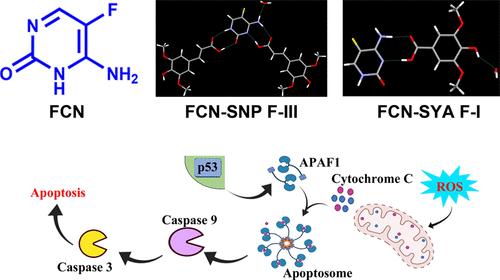当前位置:
X-MOL 学术
›
Mol. Pharmaceutics
›
论文详情
Our official English website, www.x-mol.net, welcomes your feedback! (Note: you will need to create a separate account there.)
Repurposing of Antifungal Drug Flucytosine/Flucytosine Cocrystals for Anticancer Activity against Prostate Cancer Targeting Apoptosis and Inflammatory Signaling Pathways
Molecular Pharmaceutics ( IF 4.9 ) Pub Date : 2024-04-22 , DOI: 10.1021/acs.molpharmaceut.4c00156 Manimurugan Kanagavel 1, 2 , Rajan Marystella Sparjan Samuvel 2, 3 , Vaikundamoorthy Ramalingam 2, 3 , Sunil Kumar Nechipadappu 1, 2
Molecular Pharmaceutics ( IF 4.9 ) Pub Date : 2024-04-22 , DOI: 10.1021/acs.molpharmaceut.4c00156 Manimurugan Kanagavel 1, 2 , Rajan Marystella Sparjan Samuvel 2, 3 , Vaikundamoorthy Ramalingam 2, 3 , Sunil Kumar Nechipadappu 1, 2
Affiliation

|
This study aimed to repurpose the antifungal drug flucytosine (FCN) for anticancer activity together with cocrystals of nutraceutical coformers sinapic acid (SNP) and syringic acid (SYA). The cocrystal screening experiments with SNP resulted in three cocrystal hydrate forms in which two are polymorphs, namely, FCN-SNP F–I and FCN-SNP F–II, and the third one with different stoichiometry in the asymmetric unit (1:2:1 ratio of FCN:SNP:H2O, FCN-SNP F–III). Cocrystallization with SYA resulted in two hydrated cocrystal polymorphs, namely, FCN-SYA F–I and FCN-SYA F–II. All the cocrystal polymorphs were obtained concomitantly during the slow evaporation method, and one of the polymorphs of each system was produced in bulk by the slurry method. The interaction energy and lattice energies of all cocrystal polymorphs were established using solid-state DFT calculations, and the outcomes correlated with the experimental results. Further, the in vitro cytotoxic activity of the cocrystals was determined against DU145 prostate cancer and the results showed that the FCN-based cocrystals (FCN-SNP F–III and FCN-SYA F–I) have excellent growth inhibitory activity at lower concentrations compared with parent FCN molecules. The prepared cocrystals induce apoptosis by generating oxidative stress and causing nuclear damage in prostate cancer cells. The Western blot analysis also depicted that the cocrystals downregulate the inflammatory markers such as NLRP3 and caspase-1 and upregulate the intrinsic apoptosis signaling pathway marker proteins, such as Bax, p53, and caspase-3. These findings suggest that the antifungal drug FCN can be repurposed for anticancer activity.
中文翻译:

抗真菌药物氟胞嘧啶/氟胞嘧啶共晶体的再利用,用于针对前列腺癌的抗癌活性,靶向细胞凋亡和炎症信号传导途径
本研究旨在将抗真菌药物氟胞嘧啶 (FCN) 与营养保健品共晶芥子酸 (SNP) 和丁香酸 (SYA) 的共晶体一起重新用于抗癌活性。 SNP 共晶筛选实验产生了三种共晶水合物形式,其中两种是多晶型物,即 FCN-SNP F–I 和 FCN-SNP F–II,第三种具有不同化学计量的不对称单元(1:2: 1 FCN:SNP:H 2 O 的比例,FCN-SNP F–III)。与 SYA 共结晶产生两种水合共晶多晶型物,即 FCN-SYA F–I 和 FCN-SYA F–II。所有共晶多晶型物都是在缓慢蒸发法期间同时获得的,并且每个体系的一种多晶型物是通过浆料法大量生产的。使用固态DFT计算建立了所有共晶多晶型物的相互作用能和晶格能,并且结果与实验结果相关。此外,还确定了共晶对 DU145 前列腺癌的体外细胞毒活性,结果表明基于 FCN 的共晶(FCN-SNP F–III 和 FCN-SYA F–I)在较低浓度下具有优异的生长抑制活性。与母体 FCN 分子。制备的共晶通过产生氧化应激并引起前列腺癌细胞核损伤来诱导细胞凋亡。蛋白质印迹分析还表明,共晶体下调了炎症标志物,如 NLRP3 和 caspase-1,并上调了内在的凋亡信号通路标志物蛋白,如 Bax、p53 和 caspase-3。这些发现表明抗真菌药物 FCN 可以重新用于抗癌活性。
更新日期:2024-04-22
中文翻译:

抗真菌药物氟胞嘧啶/氟胞嘧啶共晶体的再利用,用于针对前列腺癌的抗癌活性,靶向细胞凋亡和炎症信号传导途径
本研究旨在将抗真菌药物氟胞嘧啶 (FCN) 与营养保健品共晶芥子酸 (SNP) 和丁香酸 (SYA) 的共晶体一起重新用于抗癌活性。 SNP 共晶筛选实验产生了三种共晶水合物形式,其中两种是多晶型物,即 FCN-SNP F–I 和 FCN-SNP F–II,第三种具有不同化学计量的不对称单元(1:2: 1 FCN:SNP:H 2 O 的比例,FCN-SNP F–III)。与 SYA 共结晶产生两种水合共晶多晶型物,即 FCN-SYA F–I 和 FCN-SYA F–II。所有共晶多晶型物都是在缓慢蒸发法期间同时获得的,并且每个体系的一种多晶型物是通过浆料法大量生产的。使用固态DFT计算建立了所有共晶多晶型物的相互作用能和晶格能,并且结果与实验结果相关。此外,还确定了共晶对 DU145 前列腺癌的体外细胞毒活性,结果表明基于 FCN 的共晶(FCN-SNP F–III 和 FCN-SYA F–I)在较低浓度下具有优异的生长抑制活性。与母体 FCN 分子。制备的共晶通过产生氧化应激并引起前列腺癌细胞核损伤来诱导细胞凋亡。蛋白质印迹分析还表明,共晶体下调了炎症标志物,如 NLRP3 和 caspase-1,并上调了内在的凋亡信号通路标志物蛋白,如 Bax、p53 和 caspase-3。这些发现表明抗真菌药物 FCN 可以重新用于抗癌活性。






























 京公网安备 11010802027423号
京公网安备 11010802027423号